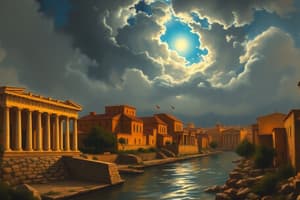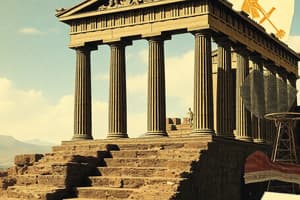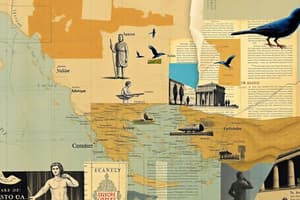Podcast
Questions and Answers
Which of the following best describes the social structure of the Mycenaeans?
Which of the following best describes the social structure of the Mycenaeans?
- An egalitarian society with no distinct social classes or leaders.
- A democratic society where all citizens participated in decision-making.
- A feudalistic society with a king at the top, followed by military, religious leaders, and other officials. (correct)
- A society focused on maritime trade with elected officials.
The Mycenaeans adopted their writing system directly from the Romans.
The Mycenaeans adopted their writing system directly from the Romans.
False (B)
What is a polis?
What is a polis?
A city state and fundamental political unit in Ancient Greece.
Which form of government in ancient Greek city-states is characterized by rule by a small group of wealthy merchants, landowners, or artisans?
Which form of government in ancient Greek city-states is characterized by rule by a small group of wealthy merchants, landowners, or artisans?
The Athenian ruler, _______, created a harsh legal code that treated all Athenians equally, from which the word 'draconian' is derived.
The Athenian ruler, _______, created a harsh legal code that treated all Athenians equally, from which the word 'draconian' is derived.
Match the Athenian ruler with his corresponding action
Match the Athenian ruler with his corresponding action
What was a key restriction on citizenship in Athens?
What was a key restriction on citizenship in Athens?
Sparta was known for its strong emphasis on art and literature.
Sparta was known for its strong emphasis on art and literature.
What military formation, adopted by the Greeks, involves soldiers interlocking their spears and shields?
What military formation, adopted by the Greeks, involves soldiers interlocking their spears and shields?
The alliance of Greek city-states formed to prevent the Persians from taking over Greece was known as the __________ League.
The alliance of Greek city-states formed to prevent the Persians from taking over Greece was known as the __________ League.
What is 'direct democracy' as practiced during the Golden Age of Athens?
What is 'direct democracy' as practiced during the Golden Age of Athens?
During the Golden Age of Athens, artists were seldom hired to improve and refine the beauty of Athens.
During the Golden Age of Athens, artists were seldom hired to improve and refine the beauty of Athens.
What empire did Alexander the Great start building after invading Greece?
What empire did Alexander the Great start building after invading Greece?
Alexander the Great was taught by __________.
Alexander the Great was taught by __________.
Which of the following is a characteristic of Hellenistic culture?
Which of the following is a characteristic of Hellenistic culture?
Rome was built on the Nile River.
Rome was built on the Nile River.
What was the role of the plebeians in the Roman Republic?
What was the role of the plebeians in the Roman Republic?
How many branches of government did the Roman Republic have?
How many branches of government did the Roman Republic have?
_______ was appointed dictator during the Republic in times of crisis and given absolute power for 6 months.
_______ was appointed dictator during the Republic in times of crisis and given absolute power for 6 months.
What was the Pax Romana?
What was the Pax Romana?
Flashcards
Who were the Mycenaeans?
Who were the Mycenaeans?
Indo-Europeans who migrated to Greece around 200 BCE, lived on steep ridges, and were surrounded by thick walls.
What is a Polis?
What is a Polis?
A fundamental political unit in Ancient Greece, consisting of a city and its surrounding countryside.
What is Monarchy?
What is Monarchy?
Rule by a single king.
What is Aristocracy?
What is Aristocracy?
Signup and view all the flashcards
What is Oligarchy?
What is Oligarchy?
Signup and view all the flashcards
What is Democracy?
What is Democracy?
Signup and view all the flashcards
Who was Draco?
Who was Draco?
Signup and view all the flashcards
Who was Solon?
Who was Solon?
Signup and view all the flashcards
Who was Cleisthenes?
Who was Cleisthenes?
Signup and view all the flashcards
What type of democracy?
What type of democracy?
Signup and view all the flashcards
What was the Delian League?
What was the Delian League?
Signup and view all the flashcards
What was Alexandria?
What was Alexandria?
Signup and view all the flashcards
What is Hellenistic Culture?
What is Hellenistic Culture?
Signup and view all the flashcards
What were the Twelve Tables?
What were the Twelve Tables?
Signup and view all the flashcards
What are the 3 branches of government?
What are the 3 branches of government?
Signup and view all the flashcards
What was Pax Romana?
What was Pax Romana?
Signup and view all the flashcards
What is Christianity?
What is Christianity?
Signup and view all the flashcards
What caused the Fall of the Roman Empire?
What caused the Fall of the Roman Empire?
Signup and view all the flashcards
Study Notes
Mycenaeans
- The Mycenaeans came from Indo-Europeans migrating to Greece around 200 BCE.
- They resided on a steep ridge and were protected by a 20 ft thick wall.
- Warrior kings ruled the Mycenaeans.
- Contact with the Minoans shifted their focus toward sea trade.
- The Mycenaeans adopted the Minoan writing system.
- Their social structure was feudalistic, featuring a king, military leaders, religious leaders, and other officials.
- Many aspects of Greek society, including art, religion, politics, and literature, began in Mycenae.
- The Mycenaean society collapsed after the Trojan War.
- The Dorians then took over and the writing system was lost for 400 years.
- Homer was a blind poet who composed epic narrative poems about Greek mythology and history, including the Trojan War.
Greece
- The Polis was a city-state and a fundamental political unit.
- It was made up of a large city and its surrounding countryside, including small villages.
- City-states had different forms of government.
- Monarchy involves rule by a single king.
- Aristocracy involves rule by a small group of noble landowning families.
- Oligarchy involves rule by a small group of wealthy merchants, land owners, or artisans.
- Democracy involves rule by the people.
Fun Athenian Rulers
- Draco created a harsh legal code that treated all Athenians equally.
- The word "draconian" comes from Draco.
- Solon organized Athens into four classes, with the top three eligible for political office.
- Solon outlawed slavery.
- Cleisthenes divided Athens into 10 groups based on residence rather than wealth.
- Cleisthenes allowed all citizens to propose laws.
Athens
- Only boys received formal education and military training.
- Girls were educated at home by other women.
- Women did not participate in Athenian public life.
- Athenian citizens were free adult male property owners born in Athens.
- Women, enslaved people, and men not born in Athens were not considered citizens.
- Athens is known for its democracy, cultural achievements, and influence on Western civilization.
- Athens led the Delian League in the Peloponnesian War against Sparta and the Peloponnesian League.
- Athens was a hub for philosophical thought, with figures like Socrates, Plato, and Aristotle shaping intellectual traditions.
Sparta
- Sparta was a militaristic society.
- They always had a security code in place.
- There was no art or literature.
- There was increased freedom for women.
Persian War
- There was a shift from bronze to iron weapons.
- Phalanx formations were used (originating from Sparta).
- The Persians were driven out of Greece.
- The Delian League was a Greek city-states alliance to prevent Persians from taking over again.
Golden Age of Athens
- Athens used direct democracy, where each person votes and majority rules.
- This was instead of representative democracy.
- Philosophers were lovers of wisdom.
- Socrates, Aristotle, and Plato were philosophers.
- The Parthenon was built on the Acropolis.
- Artists were hired to beautify Athens.
- Drama, including tragedy and comedy, were common.
Alexander the Great
- His dad was Philip II, the King of Macedonia.
- He built a strong military using phalanx formations.
- He invaded Greece and started building an empire.
- He was very well educated and taught by Aristotle.
- He became king at 20.
- He conquered Egypt first, then Persia, then India.
- He assimilated into Persian culture by dressing like Persians, marrying a Persian woman, and including Persians in his army.
Hellenistic Culture
- Alexandria was a city with astronomy and a lighthouse.
- Alexandria also had a library holding half a million papyrus scrolls.
- It was a port city and an important trade center.
- Math including geometry and physics, was studied
- Two main philosophy schools of thought.
- Epicureanism states the greatest good and highest pleasure come from virtuous conduct, which resolves problems together eliminating pain.
- Stoicism promotes living in harmony with natural laws, focusing on what can be controlled.
Early Rome
- Rome sits in the middle of the Italian boot.
- It was built on the Tiber River near the Mediterranean Sea.
- The city was surrounded by seven hills and a wall.
- The entire Italian peninsula was fairly flat farmland.
- Early kings of Rome were of Etruscan origin.
- They brought a writing system and architectural style.
- The last of these kings was a harsh tyrant which led to the birth of the republic.
Roman Republic
- The republic was a form of government in which citizens vote for leaders.
- Only freedom-born males had voting rights in Rome.
- The patricians were wealthy landowners who inherited political power.
- Plebeians were farmers, merchants, and artisans and formed the majority of the population.
- Slaves were conquered people who did both specialized work and farm work, and no one was born a slave.
- The Twelve Tables were a written law code to protect all citizens.
- Previously, all laws were unwritten.
- The government had three branches.
- The executive branch had two consuls serving one-year terms, enforcing laws, and commanding the military.
- The legislative branch consisted of a Senate of 300 members serving for life, making laws.
- The judicial branch had six judges serving one-year terms, elected by the senate, interpreting laws.
- This inspired the design of the U.S. government.
- A dictator was appointed during times of crisis with absolute power for six months.
- All land-owning citizens served in the military.
- Roman soldiers were organized in legions consisting of 5,000 armed foot soldiers (infantry) and a cavalry.
- Rome's increasing wealth and expanding geographic boundaries brought problems.
- The wealth gap caused the lower class to be unhappy with the wealth gap.
- The military was becoming disorderly.
- A third of Rome's population consisted of enslaved peoples captured in war, causing competition for middle-class Romans.
Julias Caesar
- Julius Caesar was a military leader.
- He formed a triumvirate with two other officials to keep the republic alive.
- After conquering Gaul (France), he was named dictator for life.
- He was popular and powerful, which led to senators stabbing him to death.
- He conquered half of Europe, parts of North Africa, and the Middle East.
- His nephew Augustus declared himself emperor after Caesar's death and a period of civil war which began the Pax Romana.
Pax Romana/Roman Empire
- The Pax Romana was a 200-year period of peace and prosperity.
- Augustus stabilized the borders and undertook public building projects.
- He created civil service with plebeians and former slaves who ran the empire's administration.
- He established a common currency (silver coin = denarius)
- 90% of people farmed and survived off local produce.
- Rome had a vast trade network for non-local food and luxury items.
- Roman roads extended through parts of Europe.
- Rome traded with China and India.
- There was a large naval preserve.
Rise of Christianity
- Christianity is a monotheistic religion worshipping the same God as Judaism and Islam.
- Jesus was believed to be the Son of God and a prophet or messiah figure.
- Jesus was born to the virgin Mary in land occupied by the Roman Empire.
- Jesus was crucified by the Roman governor, Pontius Pilate.
- His apostles spread the story of his life and founded a religion.
- Christianity's spread was helped by the Pax Romana and the Jewish diaspora.
- Rome slowly forced Jews out of its empire; therefore, Christianity appealed to Emperor Constantine.
- Constantine then split the empire into two halves and moved the capital to Constantinople.
The Fall of the Roman Empire
- The division of the empire was too big to control.
- ⅓ of the population were slaves.
- The military was not loyal.
- Famine and inflation occurred.
- The Roman Empire ultimately fell due to invasions by Northern Groups.
- The western half of the empire entirely fell, but the eastern half survived to become the Byzantine Empire.
- If the military is not loyal, the split of Rome would cause there to be two emperors, and the military would split in half.
Studying That Suits You
Use AI to generate personalized quizzes and flashcards to suit your learning preferences.




